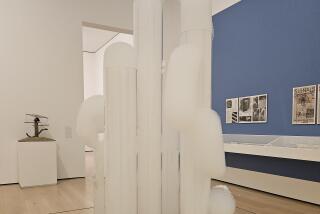Inspired by the Box
Ideally, Oscar Wilde asserted, life should imitate art--not the other, more pedestrian way around. Thus are art’s objectives and responsibilities ratcheted up to a high imaginative plateau, which gives us ample reason for paying attention to it.
Tony Oursler is an artist who has taken the 19th century writer’s admonition to heart. And he’s done it in a circuitous and wholly contemporary way--via video.
The art that today’s lives imitate most closely is not painting, sculpture, stage plays or poetry; it is television. The fact that most TV is unimaginative junk is bothersome but is not inherent to the genre. Thankfully, Oursler’s art isn’t another tiresome harangue about the supposed mass evils perpetrated by the box.
Instead, as it unfolds at the Museum of Contemporary Art in “Tony Oursler: Introjection, Mid-Career Survey 1976-1999,” the New York-based artist’s work is a sometimes trenchant, sometimes abstruse effort to unravel and empathize with the modern predicament of our cathode-ray-induced lives.
It’s an odd show, curatorially speaking. (It was organized by the Williams College Museum of Art in Massachusetts.) Despite the title, the earliest work on view is juvenilia, made in 1970 when Oursler was 13. His career is dated as having begun the year he entered art school--CalArts in Valencia--which means the show includes a considerable amount of student work: a few paintings, several single-channel videotapes and some drawings and props.
“Crying Doll” (1993), Oursler’s first video-projection on a stuffed effigy, is not included--even though it marks the beginning of his fully resolved, signature work. The catalog is excellent, among the best in recent memory of a genre notorious for its leaden tendency toward pretension. The exhibition’s installation can be confusing, without chronology and with multi-part sculptures that sometimes bump into one another, making it hard to tell where one begins and another ends.
All of Oursler’s work, whether early or mid-career, evokes the art-equivalent of a garage band aesthetic. Since television is his subject, and television is corporate, professional and slick, he sets himself apart through stark but simple contrast: His video art tends toward the cheap, jerry-built and handmade.
Take “Son of Oil” (1982), an installation with video that has the look of a junior high school play. A makeshift stage is set up before a row of folding chairs. The sloppy, poster-painted backdrop shows a fierce red-and-yellow sky, part romantic sunset and part raging inferno. Cardboard tombstones are scattered about the stage, sometimes with plastic flowers as commemorative adornment. Strings of painted paper flags, like the ones that sometimes flutter over gas stations, hang overhead, while a video monitor on which the “Son of Oil” saga unfolds is mounted inside a painted cardboard gas pump.
A production like this one is just as prepackaged for audience consumption as any episode of “Suddenly Susan,” but the cheerful crappiness of Oursler’s presentation is honest in a way commercial television never is. Ragtag manufacture is a hallmark of much of what came out of CalArts in the late 1970s and 1980s, most notably in the work of Oursler’s friend and occasional collaborator Mike Kelley. And today, when slick professionalism is also characteristic of high-ticket art, the effect is disarming in a slightly different, still refreshing way.
“Son of Oil” is essentially a single-channel video shown on a regular TV monitor, but the stage set built around it shows how Oursler was trying to get TV out of its familiar box. “Kepone Drum” (1989) takes another step in that direction. A steel drum is hilariously painted with symbols of nature’s plenty, rendered in a handicraft style worthy of Martha Stewart. Hidden inside, a video monitor reflects its taped narrative about the deadly pesticide Kepone onto an acrylic spill that appears to have leaked out onto the floor.
Deprivation, loss and tragedy are the stuff of “Son of Oil” (made in the wake of the oil embargo) and “Kepone Drum,” but they’re treated more as ordinary attributes of human existence and normal emotional life than as an occasion for a political tract. Affectionate humor is regularly encountered.
Given his all-American, garage-band aesthetic, just what was Oursler tinkering with out in his garage? In these and other works he seems to have been laboring to find a way in which to theatricalize television.
I don’t mean the imagery on television, which is theatrical in any case. I mean television as a social reality, a phenomenon that has permeated contemporary life so thoroughly as to seem wholly natural. Theatricalizing the box is a way to denature it, to restore to TV culture the exceeding strangeness of the genre.
The problem with “Son of Oil,” “Kepone Drum” and Oursler’s other early work is that it relies on masquerade to achieve its effects. Dressing up a TV monitor as a gas pump or tricking it out in the costume of a pesticide spill seems more like a typical (if down-market) corporate concealment than a disarming revelation.
In 1992 technology came to Oursler’s rescue. The Sony Corp. began to market a small video projector--smaller than a toaster--which was just what he needed. His art took off.
Oursler’s signature work, all made in the last seven or eight years, is composed of a homemade doll or effigy, onto whose head a video-face is projected. The faces babble, often delusionally.
Sometimes the effigy is smashed up in the corner by the ceiling, as if an errant ghost. Sometimes its head is wedged beneath a mattress or a chair, from which the effigy pleads to passersby to be released. In one case it’s submerged inside a cube of water, the bug-eyed face holding its breath while turning TV-blue.
In none of these sculptures is the VCR deck, the small projector or its stabilizing tripod hidden from view. The technological machinery is as much a part of the sculpture as the thrift-shop clothing, beat-up sofa or bouquet of fake flowers that are also props for Oursler’s talking heads.
Indeed, the machinery’s presence seems integral to the effect. Throughout the main gallery the television apparatus projects its ubiquitous self here, there and everywhere. TV animates lifeless bodies, right before your hypnotized eyes.
“Introjection,” the word with which the Oursler survey is titled, is a psychoanalytic term. It describes the way mental images get unconsciously incorporated into the psyche. In an electronically mediated world like ours, a whole lot of hitherto unheard of introjection is going on. Oursler’s art is a witty, disconcerting exploration of the manic process.
The work since 1992, which is the heart of the show, is marked by a bit of repetition. It leaves you feeling that, in some respects, Oursler is a one-trick pony. But this particular pony happens to be one that has mastered a perfect swan dive from Atlantic City’s Steel Pier. It’s quite a sight, and one everybody’s got to see at least once.
*
* “Tony Oursler: Introjection, Mid-Career Survey 1976-1999,” Museum of Contemporary Art, 250 S. Grand Ave., (213) 626-6222, through July 9. Closed Mondays.
More to Read
The biggest entertainment stories
Get our big stories about Hollywood, film, television, music, arts, culture and more right in your inbox as soon as they publish.
You may occasionally receive promotional content from the Los Angeles Times.











